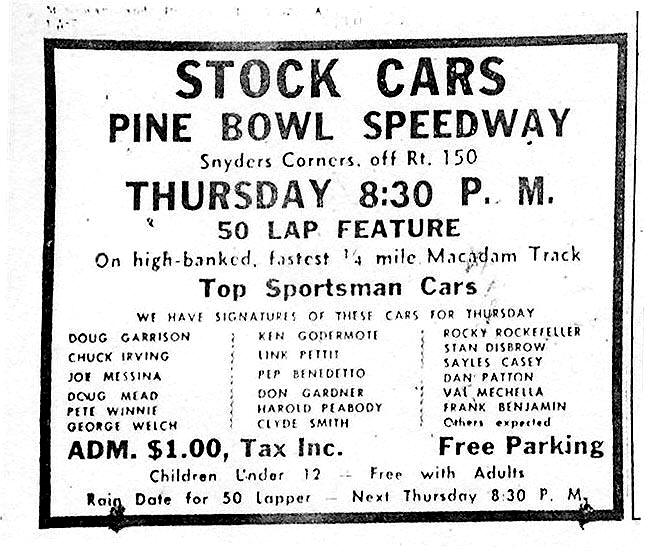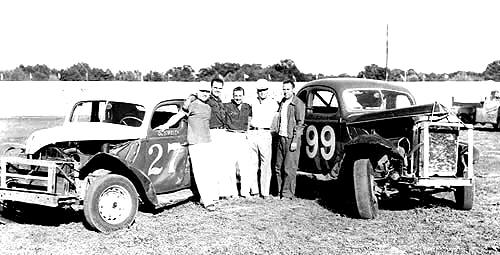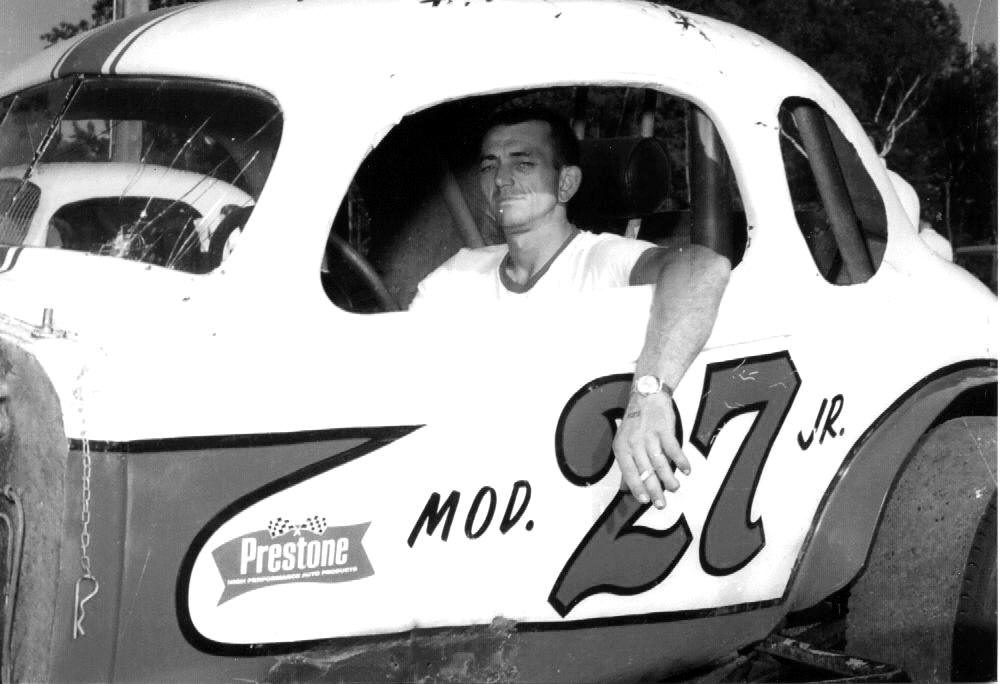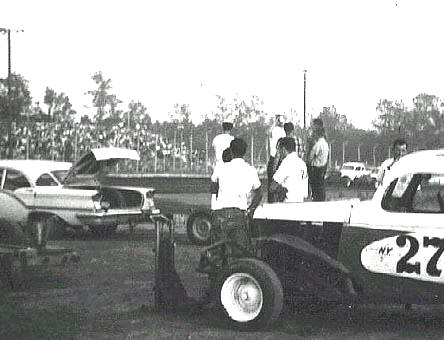THE
BILL'S BACK IN TIME COLUMN PAGE
Copies of my column in Mark Thomas' "Racin'
Paper"
Site Column #40 from Column 54
BILL’S BACK IN TIME
By Bill Ladabouche
ONE OF THE PLACES WHERE ONE
COULD RACE AMONG THE PINES
My last column was about the how the state of the economy and the sport of stock car racing , back in the 1950’s, could allow people like the late George Barber to travel extensively and nearly make a living out of racing – multiple times per week. I can’t envision anyone in today’s economy, or with the high expense of racing now, able to do anything like that. Heck, even a team with a zillion dollar sponsor seldom breaks even.
In that bygone era, tracks had sprung up everywhere. One guy at our recent lost race tracks conference at the Saratoga Auto Museum made the statement that, in some parts of New York, “damn near every town had a track of some sort or another”. Of course, that would lead to a lot of duplication in track names. For instance, I have [thus far] seen three tracks in Vermont that used the name Green Mountain Speedway.
In the old days there were a number of places you could race – if you happened to feel luckier around pine trees. Three such spots were: Norway Pines, Rumney, NH [the current Legion Speedway]; The Pines, a defunct track in northern Massachusetts; and the Pine Bowl, in the Troy, New York region.
After having attended three lost race track conferences now at Saratoga, I have com to learn a lot more about the Pine Bowl. The resident Pine Bowl expert is one Ken Gypson, from New York. Like myself, he is trying to tell the history of his chosen tracks while actually being a bit too young to have participated at them in any meaningful manner. But, if you want to know about the bucolic little oval near Snyders Corner, New York, go see Ken.
Ken Gypson now owns this old Pine Bowl sedan, and it miraculously has not
been altered or damaged by the elements. [Gypson Collection]
Apparently the Pine Bowl was one of those tracks that started out in the late 1940’s and survived into the 1960’s before having to close. [Familiar story]. It started out as a dirt track, attracting some of the region’s finest drivers of the day, from as far away as Connecticut. Probably, the fact that the area already had several other tracks helped to keep some of the more serious racers there because they could race so many times a week. Within a fairly short drive [and within about a six year time frame] there were tracks in Coxsackie, NY; Menands, NY; Troy, NY; Burden Lake, NY, North Bennington, VT; New Lebanon, NY; Ballston Lake, NY; Warrensburg, NY; Rutland, VT; Fair Haven, VT; Millers Fall, MA; West Brattleboro, VT; Keene, NH; and many more places. Any Tom, Dick, or Harry who wanted to be a promoter could throw one up in the nearest pasture large enough.
This shot of the Coxsackie, New York track is very typical of an early –
era
race oval. It may be a better facility than some. [Link Pettit Collection]
So, it wasn’t going to take much to keep any track in that region going and even prospering – provided it wasn’t run by a greedy idiot [and they had some of those around]. By 1949, someone got the idea that the track would be better paved, so they actually “hand paved” the turns only that year. Can you imagine coming up with setup for that with today’s cars ? By now the track had already seen the likes of drivers such as : Connecticut’s Bob Devine and Ted Langlois; Capital District racing pioneer Sayles Casey; Howie Westervelt and the Cliff Wright team; Carl Fink; future Valley star Jerry Townley; Mike Ehring; George Welch and the Brush Radio #27; Ken Goodermotte; Jollie Ollie Palmer; Joe Messina, and Pete Peterson – to name a few.
Carl Fink, who may have started in the roadster era, was the first driver
of the legendary 62Jr. car.
Fink went on the infamy with one of Fonda’s five all-time worst crashes. [Ken
Gypson Collection]
The track was finally paved all the way around. As a matter of fact, despite the fact it is nearly impossible to get in to see the vestiges of the track because of a none-too-friendly land owner, the track has been recently photographed [at some risk to life and limb] and it is very clear that the surface is mostly still intact – much like Northeastern Speedway in Lower Waterford, Vermont. During its run, the track really had involvement from a veritable Who’s Who of personalities from New York racing. Legendary car builder Cliff Wright was a tech inspector there; everyone from Steve Danish and Pete Corey – to Valley stars like Westervelt and Correllis raced there. Many New York stars of today had predecessors in the family who raced, wrenched or spectated at the Pine Bowl.
Ed Ryan was, from what I can ascertain, the most successful and effective of the Pine Bowl promoters. He once advertised a race there on the local WRGB, Schenectady – a bold move in those days, and had 2,100 extra people arrive. Ed had no choice but upgrade his facilities THAT DAY – on the spot. The first and most important project into which the carpenters were hurled was the construction of an additional [12 holer] outhouse just for the ladies. Keep in mind, this is DURING the show. Can’t you see something like that today ?

This was a typical flyer from the Pine Bowl in the day. There
a number of recognizable
names – some are even spelled right ! [Courtesy of Joe Grossetti]
Like other tracks of its time, the Pine Bowl was a nifty little track that played an important part in the history of our sport. A few of the tracks that started with the Pine Bowl, Rhythm Inn, Stateline, and others have been lucky enough to stand the test of time. Good thing. To try and start a track today is damn nigh impossible, especially in tree-hugging states. Claremont is an example of a tough survivor, making it through while West Brattleboro, Keene, NH, and other neighbors died out. The Pine Bowl wasn’t to be that lucky. Like Malletts Bay, whose fate certainly would have been sealed by Catamount had it even made it to 1965, the Pine Bowl wasn’t going to make it past some of the more high-powered New York tracks that came along. But, while it was there, it was a dandy !
Link Pettit puts the legendary Brush Radio 27 through its paces at the Pine Bowl in the late 1950’s. [Pettit Collection]
Speaking of the Brush Radio 27, I have been lucky enough to get quite a few pictures of that car. I’ve seen it at various tracks and with drivers Link Pettit and George Welch. I believe that the owner’s name was Jim Brush, of Schenectady, NY who fielded cars while running a successful radio store which was beginning to fool with that new fangled medium, television, as well. I have never seen a color photo of the Brush 27’s, so I cannot even venture a guess what color they were.
From what I can gather, the principal driver of the car was George Welch, also of Schenectady, who sometimes doubled as the flagman at Empire Speedway in Menands. Welch, a popular young man, also spent some time in his own NASCAR coupe, the Bain-Reakes #8. Welch may have also driven for Frank Trinkhaus, but then who didn’t ?
Welch and the Brush 27 are second from left in this four
abreast shot at Stateline.
To the left is Steve Danish.[ Courtesy of Chris Companion]
The 27 team was very active within its own region. I have photos of it running at Pine Bowl, Coxsackie, Rhinebeck, and Stateline. I have heard of it competing at a number of other tracks, as well. After a while, a second car appeared on the scene, with veteran Jollie Ollie Palmer of West Albany at the wheel. This one bore the number 27Jr. I firmly believe this is origin of the Bill Fowler 27Jrs. That ran at Fonda and surrounding tracks in the 1960’s – with Palmer and then the Kotarys at the wheel. One of the last 27 Jrs. Might have been its best, sporting young wheelman Jerry Pennock at the controls. That one ran Fonda and Fairmont – to name a couple.

Welch, Brush and the 27, in a photo with Doug Garrison, #99
owner Barney Tompkins,
another unidentified man, at Rhinebeck, NY. [Garrison Family Collection]
I had recalled Palmer from his days running at Pico Raceway, in Rutland, VT. So, when he suddenly re-appeared at Fonda, around 1963, with this red and white 27Jr. I was immediately interested. By this time, the cars were owned by former Pine Bowl driver Bill Fowler, of Schenectady. When the car made a late-season visit to Fairmont, I got a close-up view. Palmer was getting on in years by now, and the 27Jr. driving chores were handed over to Robbie Kotary, late off the 148 Ward Petit team. Robbie and his brother, Tiger Tom, drove the car in the mid 1960’s.

Robbie Kotary gives the typical cryptic Kotary stare to the
photographer
as he awaits adjustments to the Fowler car at Malta. [Grady Photo]
Some of the 27Jrs. In the Kotary era were rather strange-looking rigs, with the body pushed considerably forward on the frame. Finally, Fowler built another, more stable-looking car around 1965. He put young Warrensburg, NY driver Jerry “Porky Pennock, younger brother of Dick Pennock – who had migrated to Fonda from Fairmont and was running a late model hobby division car there. Jerry would go on to several other rides, one of the best of which was the #37 Falcon of Tony Villano. By the end of the ‘60’s, the 27Jr. was apparently discontinued.

The Fowler car sits at Fairmont around 1965. By now, Jerry
Pennock, a name
familiar to Fairmont fans, was the driver. [Ladabouche Photo]
It’s a small world, sometimes, in racing. This Pine Bowl
Speedway program shows both Jim Brush and
George Welch as officials. In the points standings, on another page, Bill Fowler
was listed as a driver.
We also see soon-to-be-prominent car owner Cliff Wright as inspector and
Stan Disbrow's wife as chief scorer. [Thanks to Ken Gypson]
Return to the Columns Link Page
Return to the Main News Page